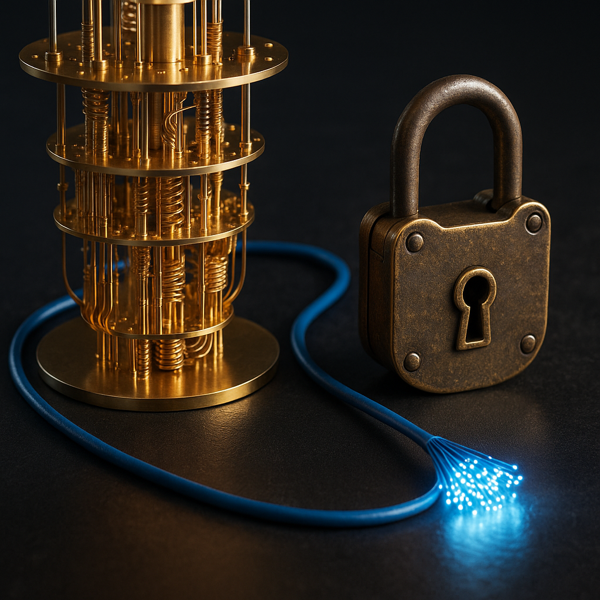“We don’t get a say about when quantum is coming — only how ready we will be when it arrives.”
Why This Matters
While quantum computers powerful enough to break today’s public‑key cryptography do not yet exist (or at least are not known to exist), the cryptographic threat is no longer theoretical. Nations, large enterprises, and research institutions are investing heavily in quantum, and the possibility of “harvest now, decrypt later” attacks means that sensitive data captured today could be exposed years down the road.
Standards bodies are already defining post‑quantum cryptographic (PQC) algorithms. Organizations that fail to build agility and transition roadmaps now risk being left behind — or worse, suffering catastrophic breaches when the quantum era arrives.
To date, many security teams lack a concrete plan or roadmap for quantum readiness. This article outlines a practical, phased approach: what quantum means for cryptography, how standards are evolving, strategies for transition, and pitfalls to avoid.
What Quantum Computing Means for Cryptography
To distill the challenge:
-
Shor’s algorithm (and related advances) threatens to break widely used asymmetric algorithms — RSA, ECC, discrete logarithm–based schemes — rendering many of our public key systems vulnerable.
-
Symmetric algorithms (AES, SHA) are more resistant; quantum can only offer a “square‑root” speedup (Grover’s algorithm), so doubling key sizes can mitigate that threat.
-
The real cryptographic crisis lies in key exchange, digital signatures, certificates, and identity systems that rely on public-key primitives.
-
Because many business systems, devices, and data have long lifetimes, we must assume some of today’s data, if intercepted, may become decryptable in the future (i.e. the “store now, crack later” model).
In short: quantum changes the assumptions undergirding modern cryptographic infrastructure.
Roadmap: PQC in Standards & Transition Phases
Over recent years, standards organizations have moved from theory to actionable transition planning:
-
NIST PQC standardization
In August 2024, NIST published the first set of FIPS‑approved PQC algorithms: lattice‑based (e.g. CRYSTALS-Kyber, CRYSTALS-Dilithium), hash-based signatures, etc. These are intended as drop-in replacements for many public-key roles. Encryption Consulting+3World Economic Forum+3NIST Pages+3 -
NIST SP 1800‑38 (Migration guidance)
The NCCoE’s “Migration to Post‑Quantum Cryptography” guide (draft) outlines a structured, multi-step migration: inventory, vendor engagement, pilot, validation, transition, deprecation. NCCoE -
Crypto‑agility discussion
NIST has released a draft whitepaper “Considerations for Achieving Crypto‑Agility” to encourage flexible architecture designs that allow seamless swapping of cryptographic primitives. AppViewX -
Regulatory & sector guidance
In the financial world, the BIS is urging quantum-readiness and structured roadmaps for banks. PostQuantum.com
Meanwhile in health care and IoT, device lifecycles necessitate quantum-ready cryptographic design now. medcrypt.com
Typical projected milestones that many organizations use as heuristics include:
| Milestone | Target Year |
|---|---|
| Inventory & vendor engagement | 2025–2027 |
| Pilot / hybrid deployment | 2027–2029 |
| Broader production adoption | 2030–2032 |
| Deprecation of legacy / full PQC | By 2035 (or earlier in some sectors) |
These are not firm deadlines, but they reflect common planning horizons in current guidance documents.
Transition Strategies & Building Crypto Agility
Because migrating cryptography is neither trivial nor instantaneous, your strategy should emphasize flexibility, modularity, and iterative deployment.
Core principles of a good transition:
-
Decouple cryptographic logic
Design your code, libraries, and systems so that the cryptographic algorithm (or provider) can be replaced without large structural rewrites. -
Layered abstraction / adapters
Use cryptographic abstraction layers or interfaces, so that switching from RSA → PQC → hybrid to full PQC is easier. -
Support multi‑suite / multi‑algorithm negotiation
Protocols should permit negotiation of algorithm suites (classical, hybrid, PQC) as capabilities evolve. -
Vendor and library alignment
Engage vendors early: ensure they support your agility goals, supply chain updates, and PQC readiness (or roadmaps). -
Monitor performance & interoperability tradeoffs
PQC algorithms generally have larger key sizes, signature sizes, or overheads. Be ready to benchmark and tune. -
Fallback and downgrade-safe methods
In early phases, include fallback to known-good classical algorithms, with strict controls and fallbacks flagged.
In other words: don’t wait to refactor your architecture so that cryptography is a replaceable module.
Hybrid Deployments: The Interim Bridge
During the transition period, hybrid schemes (classical + PQC) will be critical for layered security and incremental adoption.
-
Hybrid key exchange / signatures
Many protocols propose combining classical and PQC algorithms (e.g. ECDH + Kyber) so that breaking one does not compromise the entire key. arXiv -
Dual‑stack deployment
Some servers may advertise both classical and PQC capabilities, negotiating which path to use. -
Parallel validation / testing mode
Run PQC in “passive mode” — generate PQC signatures or keys, but don’t yet rely on them — to collect metrics, test for interoperability, and validate correctness.
Hybrid deployments allow early testing and gradual adoption without fully abandoning classical cryptography until PQC maturity and confidence are achieved.
Asset Discovery & Cryptographic Inventory
One of the first and most critical steps is to build a full inventory of cryptographic use in your environment:
-
Catalog which assets (applications, services, APIs, devices, endpoints) use public-key cryptography (for key exchange, digital signatures, identity, etc.).
-
Use automated tools or static analysis to detect cryptographic algorithm usage in code, binaries, libraries, embedded firmware, TLS stacks, PKI, hardware security modules.
-
Identify dependencies and software libraries (open source, vendor libraries) that may embed vulnerable algorithms.
-
Map data flows, encryption boundaries, and cryptographic trust zones (e.g. cross‑domain, cross‑site, legacy systems).
-
Assess lifespan: which systems or data are going to persist into the 2030s? Those deserve priority.
The NIST migration guide emphasizes that a cryptographic inventory is foundational and must be revisited as you migrate. NCCoE
Without comprehensive visibility, you risk blind spots or legacy systems that never get upgraded.
Testing & Validation Framework
Transitioning cryptographic schemes is a high-stakes activity. You’ll need a robust framework to test correctness, performance, security, and compatibility.
Key components:
-
Functional correctness tests
Ensure new PQC signatures, key exchanges, and validations interoperate correctly with clients, servers, APIs, and cross-vendor systems. -
Interoperability tests
Test across different library implementations, versions, OS, devices, cryptographic modules (HSMs, TPMs), firmware, etc. -
Performance benchmarking
Monitor latency, CPU, memory, and network overhead. Some PQC schemes have larger signatures or keys, so assess impact under load. -
Security analysis & fuzzing
Integrate fuzz testing around PQC inputs, edge conditions, degenerate cases, and fallback logic to catch vulnerabilities. -
Backwards compatibility / rollback plans
Include “off-ramps” in case PQC adoption causes unanticipated failures, with graceful rollback to classical crypto where safe. -
Continuous regression & monitoring
As PQC libraries evolve, maintain regression suites ensuring no backward-compatibility breakage or cryptographic regressions.
You should aim to embed PQC in your CI/CD and DevSecOps pipelines early, so that changes are automatically tested and verified.
Barriers, Pitfalls, & Risk Mitigation
No transition is without challenges. Below are common obstacles and how to mitigate them:
| Challenge | Pitfall | Mitigation |
|---|---|---|
| Performance / overhead | Some PQC algorithms bring large keys, heavy memory or CPU usage | Benchmark early, select PQC suites suited to your use case (e.g. low-latency, embedded), optimize or tune cryptographic libraries |
| Vendor or ecosystem lag | Lack of PQC support in software, libraries, devices, or firmware | Engage vendors early, request PQC roadmaps, prefer components with modular crypto, sponsor PQC support projects |
| Interoperability issues | PQC standards are still maturing; multiple implementations may vary | Use hybrid negotiation, test across vendors, maintain fallbacks, participate in interoperability test beds |
| Supply chain surprises | Upstream components (third-party libraries, devices) embed hard‑coded crypto | Demand transparency, require crypto-agility clauses, vet supplier crypto plans, enforce security requirements |
| Legacy / embedded systems | Systems cannot be upgraded (e.g. firmware, IoT, industrial devices) | Prioritize replacement or isolation, use compensating controls, segment legacy systems away from critical domains |
| Budget, skills, and complexity | The costs and human capital required may be significant | Start small, build a phased plan, reuse existing resources, invest in training, enlist external expertise |
| Incorrect or incomplete inventory | Missing cryptographic dependencies lead to breakout vulnerabilities | Use automated discovery tools, validate by code review and runtime analysis, maintain continuous updates |
| Overconfidence or “wait and see” mindset | Delay transition until quantum threat is immediate, losing lead time | Educate leadership, model risk of “harvest now, decrypt later,” push incremental wins early |
Mitigation strategy is about managing risk over time — you may not jump to full PQC overnight, but you can reduce exposure in controlled steps.
When to Accelerate vs When to Wait
How do you decide whether to push harder or hold off?
Signals to accelerate:
-
You store or transmit highly sensitive data with long lifetimes (intellectual property, health, financial, national security).
-
Regulatory, compliance, or sector guidance (e.g. finance, energy) begins demanding or recommending PQC.
-
Your system has a long development lifecycle (embedded, medical, industrial) — you must bake in agility early.
-
You have established inventory and architecture foundations, so investment can scale linearly.
-
Vendor ecosystem is starting to support PQC, making adoption less risky.
-
You detect a credible quantum threat to your peer organizations or competitors.
Reasons to delay or pace carefully:
-
PQC implementations or libraries for your use cases are immature or lack hardening.
-
Performance or resource constraints render PQC impractical today.
-
Interoperability with external partners or clients (who are not quantum-ready) is a blocking dependency.
-
Budget or staffing constraints overwhelm other higher-priority security work.
-
Your data’s retention horizon is short (e.g. ephemeral, ephemeral sessions) and quantum risk is lower.
In most real-world organizations, the optimal path is measured acceleration: begin early but respect engineering and operational constraints.
Suggested Phased Approach (High-Level Roadmap)
-
Awareness & executive buy-in
Educate leadership on quantum risk, “harvest now, decrypt later,” and the cost of delay. -
Inventory & discovery
Build cryptographic asset maps (applications, services, libraries, devices) and identify high-risk systems. -
Agility refactoring
Modularize cryptographic logic, build adapter layers, adopt negotiation frameworks. -
Vendor engagement & alignment
Query, influence, and iterate vendor support for PQC and crypto‑agility. -
Pilot / hybrid deployment
Test PQC in non-critical systems or in hybrid mode, collect metrics, validate interoperability. -
Incremental rollout
Expand to more use cases, deprecate classical algorithms gradually, monitor downstream dependencies. -
Full transition & decommissioning
Remove legacy vulnerable algorithms, enforce PQC-only policies, archive or destroy old keys. -
Sustain & evolve
Monitor PQC algorithm evolution or deprecation, incorporate new variants, update interoperability as standards evolve.
Conclusion & Call to Action
Quantum readiness is no longer a distant, speculative concept — it’s fast becoming an operational requirement for organizations serious about long-term data protection.
But readiness doesn’t mean rushing blindly into PQC. The successful path is incremental, agile, and risk-managed:
-
Start with visibility and inventory
-
Build architecture that supports change
-
Pilot carefully with hybrid strategies
-
Leverage community and standards
-
Monitor performance and evolve your approach
If you haven’t already, now is the time to begin — even a year of head start can mean the difference between being proactive versus scrambling under crisis.
* AI tools were used as a research assistant for this content, but human moderation and writing are also included. The included images are AI-generated.



